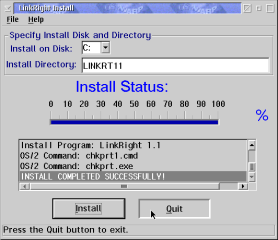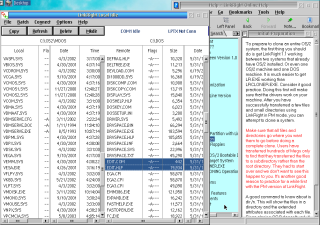|
LinkRight v. 1.1 (19/7/1994, Rightware Inc, Jeff Tremble) |
Readme/What's new |
LATE BREAKING NEWS AND INFORMATION
The last few weeks before release of LinkRight 1.1 was spent
fixing major bugs and finding and documenting minor bugs.
There are lots of minor bugs and we're sure that more will
be found after release. With any luck, no major bugs will
be discovered.
Doing files transfer thru the parallel port can cause OS/2
to crash (Trap 0008), but there are workarounds. First the
symptoms. You transfer a 5 meg, 10 meg, 50 meg and hundreds
of files, but then OS/2 crashes. This is probably caused by
a bug in COM.SYS. One workaround is to REM out the statement
in your config.sys that installs COM.SYS and VCOM.SYS.
Another workaround is to add the ignore spurious interupt switch
to the com driver:
DEVICE=C:\OS2\COM.SYS (1, 03F8, 4, I) (2, 02F8, 3, I)
Or you can apply OS/2 fix XR0F037. It goes on top of OS/2 2.11.
Contact IBM for this fix. Reference APAR PJ09132.
If this bug still occurs, set LinkRight to the lowest packet
size, transfer and verify, and turbo mode off. This may help.
This problem occurs most when you connect a fast system to a
relatively slower system.
Although it makes no sense for the COM driver to cause crashes
during parallel port transfers, that seems to be what is
happening. If you get the crash, write down all the register
info, and call IBM, they will tell you to apply fix XR0F037.
The results for our testing indicate much higher reliability
with this fix, slightly less reliability with no COM driver
installed, and and less reliability with just spurious ints
disabled. We'll keep looking at this problem for the best
solution, since not everyone can get IBM fixes.
A significant bug that is leftover from version 1.0 is that
LinkRight CANNOT BE RUN FROM THE ROOT DIRECTORY. It must be
run from a subdirectory. The reason for this is that LR builds
some temp files and uses a basepath onto which it appends
filenames. If the basepath is the root directory, LinkRight
FAILS MISERABLY. Most people who have run LinkRight from the
root did so to try to correct another percieved problem. If
they tried to change to the parent directory (equivalent to
doing "cd .." at an OS/2 command prompt) and failed, they
figured they could navigate to where they wanted to go by
starting LR in the root directory. This scheme won't work,
don't try. If you want to change to the parent directory,
double click on the line with ".." (double dots) on it.
The Event Log can grow to be rather large. If you select to
View a large (> 50K) Event Log, it may not display properly
and may take a long time to display. We suggest using EPM.EXE
or E.EXE to view a large log.
We've had a report from a beta tester that after he deletes
the Event Log or Error Log, in the same session he can not
View the log. Although we can't duplicate this problem, we
thought we should warn you about it. Caution should be taken
when clearing logs. Make sure the Local machine is Idle (not
transferring files) when clearing a log.
Some machines with 16550 UARTs boot with the setting of
"buffer=auto". LinkRight does not change this setting, but
should. The proper setting is "buffer=on". To check this
setting for COM1, type "mode COM1" at an OS/2 prompt. To
change this setting, enter "mode COM1 buffer=on". Other
COMs can be checked and changed in the same way.
As a last resort if you're having problems, shutdown and
reboot the OS/2 system. In one case during testing, a
LinkRight session was killed and ended abnormally. We
started LinkRight to run more tests, but could not
establish a connection using par ports. But after rebooting
the system, everything was fine. Evidently the LRPAR.SYS
driver did not close properly on an abnormal exit. This
only happened once, and no matter what we tried we could not
duplicate this problem. Obviously, this suggestion won't
help if you've never been able to sucessfully establish a
connection, but if LinkRight has been working well and then
all of a sudden quits working, you might try this.
As a first resort if you're having problems on a DOS
machine, reboot it.
When attempting to clone a system, do not mix and match OS/2 2.1
and OS/2 2.11 executables ON THE SAME COMPUTER. In other words,
if your modified bootable floppies were created from original
2.1 diskettes, make sure that EAUTIL.EXE and CMD.EXE on the
target system are from OS/2 2.1. Also, make sure the path is
set so that it will use EAUTIL and CMD in C:\TEMP, rather than
any EAUTIL.EXE or CMD.EXE that has been transferred to the
target system during cloning. Symptoms of this problem include
an error msg saying "Wrong Operating System Version" or EAUTIL
failed.
In some ways, it is easier and less trouble prone to use 2.1
bootable floppies no matter what is on the Source system. In
other ways, it is easiest to use bootable floppies of the version
of OS/2 that is being cloned. Use your own judgement on this one.
BOOT21.ZIP, which can be found on Compuserve and most good OS/2
BBSs, can be used to create a single bootable diskette.
Good Luck and Happy Computing.
Jeff Tremble
President, Rightware |





Aggiungi un commento